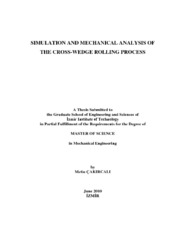Please use this identifier to cite or link to this item:
https://hdl.handle.net/11147/3795Full metadata record
| DC Field | Value | Language |
|---|---|---|
| dc.contributor.advisor | Güden, Mustafa | - |
| dc.contributor.author | Çakırcalı, Metin | - |
| dc.date.accessioned | 2014-07-22T13:52:23Z | - |
| dc.date.available | 2014-07-22T13:52:23Z | - |
| dc.date.issued | 2010 | - |
| dc.identifier.uri | http://hdl.handle.net/11147/3795 | - |
| dc.description | Thesis (Master)--Izmir Institute of Technology, Mechanical Engineering, Izmir, 2010 | en_US |
| dc.description | Includes bibliographical references (leaves: 143-146) | en_US |
| dc.description | xvii, leaves | en_US |
| dc.description.abstract | The effect of process parameters including forming angle, stretching angle, area reduction and friction coefficient on the cross-wedge rolling (CWR) of AISI 1045 steel and Ti6Al4V alloy workpiece was investigated numerically using thermo-mechanical model analysis. The numerical simulations were further validated experimentally. The thermo-mechanical analysis showed the general trends of the variations of the temperature, effective strain and stress, maximum principal stress, mean stress, stress triaxiality and strain rate of the workpiece during high and low temperature CWR process. The temperature distribution in the workpiece was shown to be non-uniform during CWR process. When the initial temperature of the workpiece was relatively low, the workpiece temperature increased, a heating effect of the plastic deformation, while higher initial temperatures caused the cooling of the workpiece. The most significant process parameters on the deformation of the workpiece in CWR were shown, for the studied range of parameters, to be the area reduction and stretching angle. Both were found to increase the tool forces. The friction coefficient between tool and workpiece was found not to affect the workpiece deformation significantly after a value of 0.3. The failure in CWR was shown to occur numerically in the midsections of the workpiece, where the stress triaxiality was maximum. The determined cruciform shaped crack also agreed with the experimentally observed crack shape. Finally, it was shown that the final microstructure of the workpiece was greatly affected by the workpiece initial temperature. | en_US |
| dc.language.iso | en | en_US |
| dc.publisher | Izmir Institute of Technology | en_US |
| dc.rights | info:eu-repo/semantics/openAccess | en_US |
| dc.subject.lcsh | Cams | en |
| dc.subject.lcsh | Rolling contact | en |
| dc.title | Simulation and Mechanical Analysis of the Cross-Wedge Rolling Process | en_US |
| dc.type | Master Thesis | en_US |
| dc.institutionauthor | Çakırcalı, Metin | - |
| dc.department | Thesis (Master)--İzmir Institute of Technology, Mechanical Engineering | en_US |
| dc.relation.publicationcategory | Tez | en_US |
| dc.identifier.wosquality | N/A | - |
| dc.identifier.scopusquality | N/A | - |
| item.openairecristype | http://purl.org/coar/resource_type/c_18cf | - |
| item.languageiso639-1 | en | - |
| item.openairetype | Master Thesis | - |
| item.grantfulltext | open | - |
| item.fulltext | With Fulltext | - |
| item.cerifentitytype | Publications | - |
| Appears in Collections: | Master Degree / Yüksek Lisans Tezleri | |
Files in This Item:
| File | Description | Size | Format | |
|---|---|---|---|---|
| T000835.pdf | MasterThesis | 25.58 MB | Adobe PDF |  View/Open |
CORE Recommender
Page view(s)
286
checked on Mar 31, 2025
Download(s)
158
checked on Mar 31, 2025
Google ScholarTM
Check
Items in GCRIS Repository are protected by copyright, with all rights reserved, unless otherwise indicated.